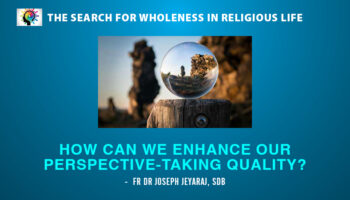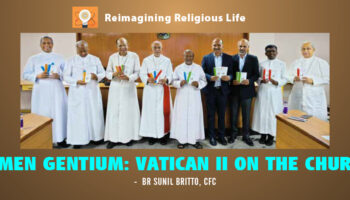In this article, the author explains how a hopeful and optimistic attitude promotes happiness and even better physical health.
Through careful planning and years of hard work, Rajan, 47, had built up a thriving textile business. He had just invested a good amount of money to improve his facilities when an accidental fire destroyed all that he had built up. He was devastated.
The fire gutted his business, but not his spirit. Recovering from the shock, he was determined to rebuild his business. He was confident he could do it. Instead of brooding and lamenting over his loss, he set about finding ways and means. He first approached the insurance company. He was told it would take some time before he would be reimbursed.
He then approached a bank for loans. It refused. He went to another … and another, and kept going from bank to bank. They all refused. He realized he was not going to get the loans he needed. But he did not give up. He knew he would find a way.
And that way was selling his large house and surrounding land and moving into a small apartment with his family. With the money from the sale, he started his business again on a very small scale. Meanwhile he received remuneration from the insurance company. Slowly the business expanded and today ten years later, his business ventures are thriving.
Rajan lived with hope. He believed he would succeed and he worked hard to make his dream come true.
Hope is the conviction of having a meaningful future despite obstacles and also choosing the path to make that future real.
Persons high on hope have visions of who they want to be and what they want to accomplish in life and are able to motivate themselves; they feel resourceful accomplishing their objectives.
Hope and optimism go together. Optimism provides us with a faith that the future is going to be bright, that we can accomplish our goals, whatever they may be. When in a tight spot, we reassure ourselves that things will get better.
Hope includes practical pathways to realize the bright future we envisage. We persist in seeking goals despite setbacks and obstacles. We are also flexible enough to find different ways to get to our goals or to switch goals, if needed.
Two types of thinking
This is the understanding of hope provided by C. R. Snyder, the leading psychologist exploring hope. Snyder and his colleagues have come up with what they call the “Hope Theory.” The theory holds that hope involves two types of thinking: agency thinking and pathway thinking.
Agency thinking refers to an individual’s determination to achieve his or her goals despite possible obstacles; pathway thinking refers to the ways in which an individual believes she or he can achieve these personal goals.
Agency thinking reflects the self-referential thoughts of success in one’s endeavor. High-hope persons embrace such self-talk phrases as “I can do this” and “I am not going to be stopped.”
Pathways thinking involves generating an effective route to a desired goal. When that route does not bear the desired fruit, high-hope persons are able to create alternate routes and persist until desired outcomes are realized. Hope calls for will power, says Snyder.
Not wishful thinking
Hope, thus, is not mere wishful thinking, an illusion. It is real. It involves having goals and working towards realization of those goals, despite obstacles. Hope calls for determination and commitment. Hope was aptly expressed in Barack Obama’s famous election slogan. “Yes, We Can!” But then he had an army of committed volunteers working hard to make the dream come true.
The twin dimensions of hope presented by Snyder and colleagues – agency thinking and pathway thinking – are illustrated in the beautiful Gospel story of healing of the woman with the hemorrhages (Mark, 5, 24-35). This woman, who had been suffering from chronic hemorrhages over a period of years, had spent her life savings on doctors in hope of healing, but with little positive outcome. Yet, she did not give up. She persisted in her hope that she would be healed. She took an alternate pathway to healing. She believed that if she could touch Jesus’s garment she would be healed. In spite of the hurdles before her, she made her way to Jesus and touched the hem of his garment. And she was healed.
Benefits of hope
A large body of research shows that hope promotes health and happiness. Hope buffers people against a number of physical and mental problems and helps people heal faster and easier. Individuals who maintain high levels of hope when battling illness significantly enhance their chances of recovery. They remain appropriately energized and focused on what they need to do in order to recuperate. Persons with high hope also engage in more preventative behaviors (i.e., physical exercise) than those with low hope.
Research shows that optimistic persons are less prone to depression, anxiety and anger, and more likely to experience life satisfaction, positive physical and mental health, self-esteem, ability to adapt and cope in various situations and longer life.
One research that followed 1,300 men in their 60s over a ten-year period found that the more optimistic men were about half as likely to develop heart disease as the more pessimistic men.
Researchers at the University of Illinois at Urbana assessed the cardiovascular health of more than 5,100 adults aged 45 to 84. They had participants complete surveys about their mental health, levels of optimism and physical health. It was found that the most optimistic participants were twice more likely to be in far better cardiovascular health than their pessimistic counterparts. Optimists had also significantly lower blood sugar and cholesterol levels.
Studies have also shown that a health care professional’s positive expectations that raise the patient’s level of hope can have a concrete impact on the health of the patient.
Why placebo works
Hope is a major ingredient in “placebo’ studies. In such studies one group of people are made to believe that they are being given a very effective treatment (when in reality they are not), while another group is actually given an effective treatment. Results often show that both groups benefit. It was the belief (hope) that they would benefit that led to improvement in the first group.
In general, people who possess hope and think optimistically have a greater sense of wellbeing, in addition to the improved health outcomes outlined above. Hope evokes positive emotions and reduces negative ones. Hope has been found to release endorphins which create a pleasurable mood and a feeling of wellbeing.
Hope is a high motivator and facilitates success in one’s endavours. Hope has been found to relate to higher achievement test scores among students. Athletes with high as compared with low hope perform significantly better in their events.
Living hopefully, thus, leads to health and happiness as well as success in life. It would be worthwhile for us to cultivate hope which calls for fighting a pessimistic outlook on life and developing optimistic attitudes and working persistently toward goal realization.
INTROSPECTION
- Do I generally have an optimistic or pessimistic outlook on life?
- Do I easily give up when I face obstacles, or do I persist in my efforts until I succeed?
- Do I tend to persist with unsuccessful pathways or to create new pathways that will lead to success?

To subscribe to the magazine Contact Us





